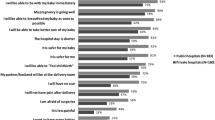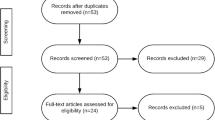Abstract
Objective: To assess consumer preference for two methods of induction of labour using stated preference discrete choice modelling. The methods of induction were artificial rupture of the membranes (ARM) plus oxytocin and dinoprostone (prostaglandin E2) vaginal gel, followed by oxytocin if necessary.
Methods: Consumer preference was measured in terms of willingness to pay for each of the attributes. These attributes were the method of administration, place of care, length of time from induction to delivery, need for epidural anaesthetic, type of delivery and cost. Levels were assigned to each of the attributes. Pregnant women attending a public hospital antenatal clinic were asked to read a description of the two methods and then to choose between them in 18 different scenarios in which the levels of the attributes were varied.
Results: Women were willing to pay 11 Australian dollars ($A) for a 1% reduction in the chance of needing oxytocin as well as the gel and $A55 for every 1 hour reduction in the length of time from induction to delivery. For a 1% reduction in the chance of needing an epidural anaesthetic or Caesarean section, women expressed a willingness to pay of $A20 and $A90, respectively. All estimates were obtained in 1998 and expressed in Australian dollars ($A1 = $US0.63).
Conclusion: Women valued the less invasive method of administration of the gel and the associated greater freedom of movement during labour. However, they valued the shorter time from induction to delivery associated with ARM plus oxytocin more highly. A policy which allows women access to the gel for up to two doses would accommodate this consumer preference.









Similar content being viewed by others
References
Gafni A. Willingness to pay: what’s in a name? Pharmacoeconomics 1998; 14 (5): 465–70
Johannesson M, Jonsson B. Economic evaluation in health care: is there a role for cost benefit analysis? Health Policy 1991; 17: 1–23
Donaldson C, Shackley P, Abdalla M. Using willingness to pay to value close substitutes: carrier screening for cystic fibrosis revisited. Health Econ 1997; 6: 145–59
Ryan M. A role for conjoint analysis in technology assessment in health care? Int J Technol Assess Health Care 1999; 15: 443–57
O’Brien BJ, Novosel S, Torrance G, et al. Assessing the economic value of a new antidepressant-a willingness to pay approach. Pharmacoeconomics 1995; 8: 34–45
O’Brien BJ, Goeree R, Gafni A, et al. Assessing the value of a new pharmaceutical: a feasibility study of contingent valuation in managed care. Med Care 1998; 36: 370–84
Zethraeus N. Willingness to pay for hormone replacement therapy. Health Econ 1998; 7: 31–8
Davey P, Grainger D, MacMillan J, et al. Economic evaluation of insulin lispro versus neutral (regular) insulin therapy using a willingness-to-pay approach. Pharmacoeconomics 1998; 13: 347–58
Taylor SJ, Armour CL. Measurement of consumer preference for treatments to induce labour: a willingness to pay approach. Health Expect 2000; 3: 203–16
Upjohn. Prostin E2 vaginal gel: as close to “natural” as labour induction can be. Sydney, Australia: Upjohn, 1991
Taylor SJ, Peat JK, Armour CL. An evaluation of Prostaglandin E2 vaginal gel use in practice. J Clin Pharm Ther 1999; 24: 303–10
Hahn GJ, Shapiro SS. A catalogue and computer programme for the design and analysis of orthogonal symmetric and asymmetric fractional factorial experiments. Schenectady (NY): General Electric Research and Development Center, 1964
Hair JFJ, Anderson RE, Tatham RL, et al. Multivariate data analysis with readings. 4th ed. New Jersey: Prentice Hall, 1995
McFadden D. Conditional logit analysis of qualitative choice behaviour. Berkley (CA): University of California, 1973
Greene WH. LIMDEP version 7, user’s manual. Plainview (NY): Econometric Software Inc, 1998
Ryan M. Using conjoint analysis to take account of patient preferences and go beyond health outcomes: an application to in vitro fertilisation. Soc Sci Med 1999; 48: 535–46
Domencich TA, McFadden D. Urban travel demand: a behavioral analysis. Amsterdam: North-Holland Publishing Company, 1975
Scott A. Giving things up to have more of others: the implications of limited suitability for eliciting preferences in health and health care [discussion paper 01/98]. Aberdeen: Health Economics Research Unit, University of Aberdeen, 1998
Ryan M, Hughes J. Using conjoint analysis to assess women’s preferences for miscarriage management. Health Econ 1997; 6: 261–73
Vick S, Scott A. Agency in health care: examining patients’ preferences for attributes of the doctor-patient relationship. J Health Econ 1998; 17: 587–605
Bryan S, Buxton M, Sheldon R, et al. Magnetic resonance imaging for the investigation of knee injuries: an investigation of preferences. Health Econ 1998; 7: 595–603
Chinburapa V, Larson LN. Predicting prescribing intention and assessing drug attribute importance using conjoint analysis. J Pharm Mark Manage 1988; 3: 3–18
Ratcliffe J, Buxton M. Patients’ preferences regarding the process and outcomes of life-saving technology. Int J Technol Assess Health Care 1999; 15: 340–51
Propper C. The disutility of time spent on the United Kingdom’s National Health Service waiting lists. J Hum Resour 1995; 30: 677–700
McIntosh E, Donaldson C, Ryan M. Recent advances in the methods of cost-benefit analysis in health care. Pharmacoeconomics 1999; 15 (4): 357–67
Dawes RM, Corrigan B. Linear models in decision making. Psychol Bull 1974; 81 (2): 95–106
Emery D, Barron F. Axiomatic and numerical conjoint measurement: an evaluation of diagnostic efficacy. Psychometrika 1979; 44: 195–210
Cramer IS. The logit model: an introduction for economists. New York: Edward Arnold, 1991
Acknowledgements
We are very grateful to Dr Andrew Child, the Director of Obstetrics and Gynaecology at King George V Hospital, Sydney for his support for this project. In addition, we would like to thank Mai Lee, the Nursing Unit Manager of the Outpatient Clinics, and her staff for their co-operation during the data collection period in the clinics. Finally we would like to thank the Pharmacy Board of NSW for their financial assistance.
This study was supported financially by the Pharmacy Board of NSW. However, there were and are no conflicts of interest relevant to the content of this manuscript.
Author information
Authors and Affiliations
Corresponding author
Rights and permissions
About this article
Cite this article
Taylor, S.J., Armour, C.L. Consumer Preference for Dinoprostone Vaginal Gel Using Stated Preference Discrete Choice Modelling. Pharmacoeconomics 21, 721–735 (2003). https://doi.org/10.2165/00019053-200321100-00004
Published:
Issue Date:
DOI: https://doi.org/10.2165/00019053-200321100-00004




